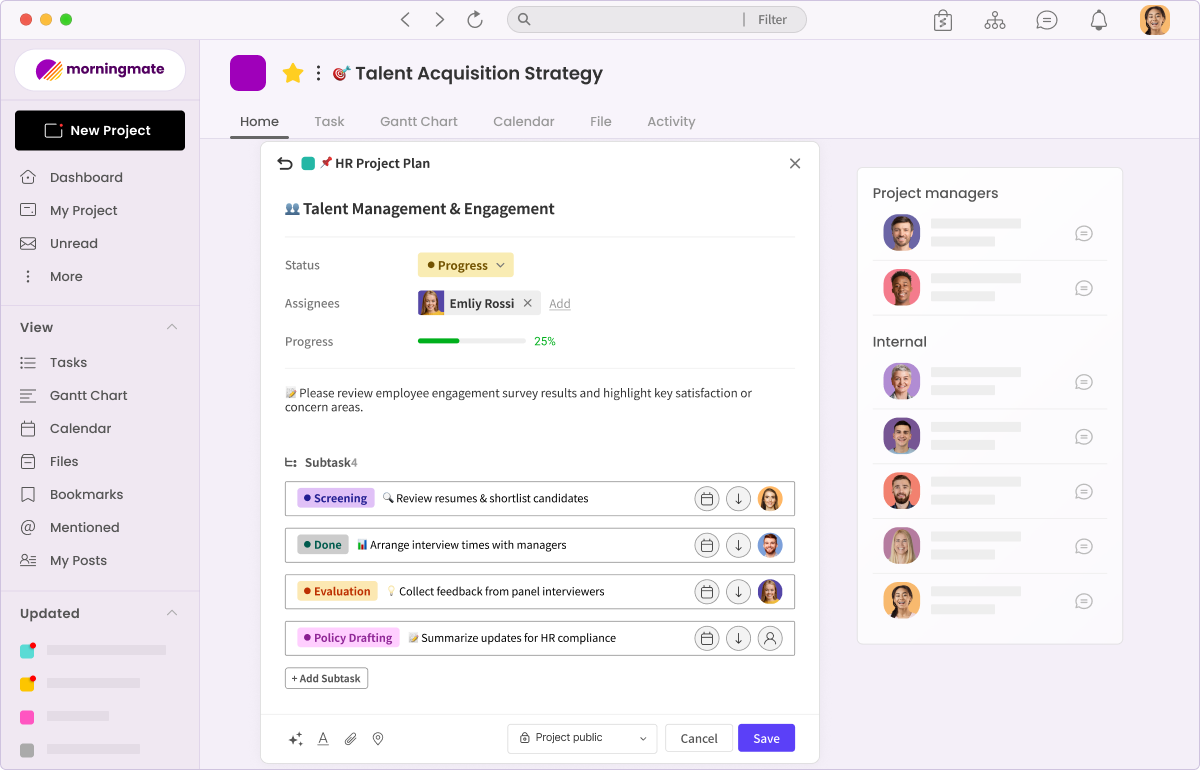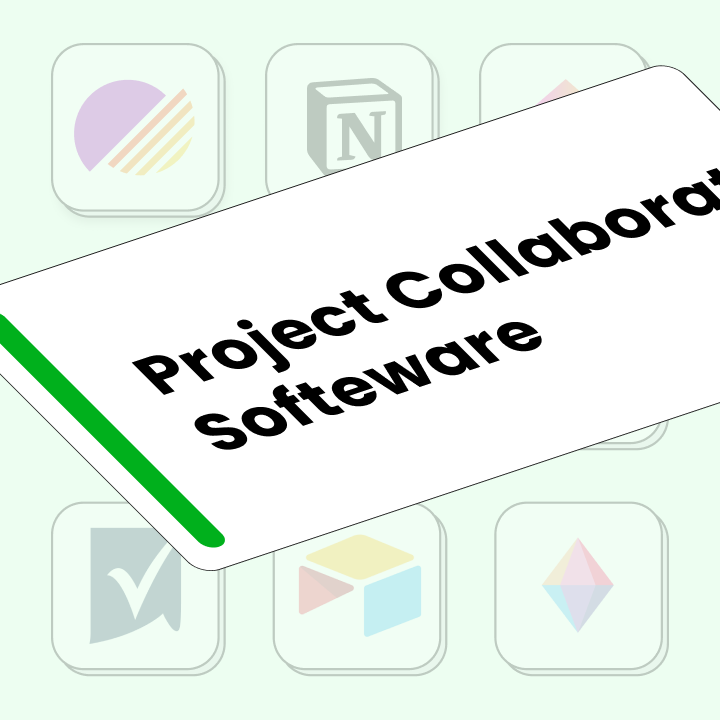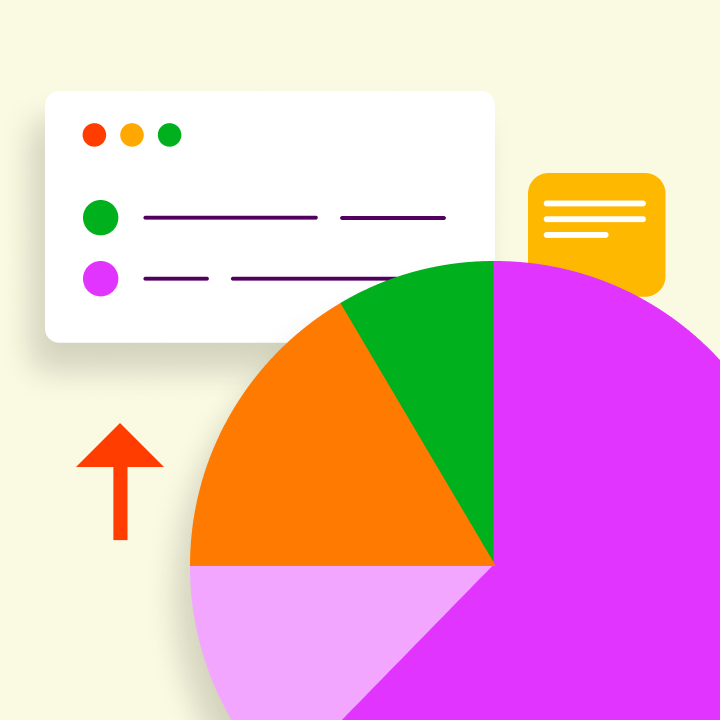Coordinating a project with a team split between online and in-person settings can be challenging. Switching between multiple apps can lead to confusion and lost focus. Collaborative project management tools streamline planning, file sharing, and task tracking into a single platform, reducing chaos and enhancing productivity.
This article explores the best teamwork tools that simplify communication and clarify tasks. These tools facilitate collaborative project management by ensuring everyone stays informed, completes tasks more efficiently, minimizes errors, saves time, enhances focus, reduces stress, and ultimately leads to more successful projects.
What Is Collaborative Project Management?
Collaborative project management brings the entire team together in a virtual space, even if some members are in different time zones. A quick glance at the project board, a brief status update, or a casual question in the chat keeps everyone informed.
With all tasks visible, team members no longer need to chase notifications or wonder who is responsible for what. They can check in, identify duplicates immediately, and share notes before delays occur. This approach is particularly effective for remote teams and projects that continually evolve.
Key Differences from Traditional Project Management
In traditional project management, one person typically directs the team while others simply follow orders. Questions and updates often funnel through that single leader, which can slow down progress and extend deadlines. This structure can feel rigid, leaving team members uncertain about the next steps.
In contrast, collaborative project management fosters open communication among all team members from start to finish. Everyone can contribute, adjust tasks, and share insights whenever needed. This leads to quicker progress, more effective problem-solving, and a flexible work environment.
Why Project Collaboration Matters in Modern Workflows
The pace of work is fast, and team dynamics can shift rapidly. This is why having a centralized platform for collaboration is essential. New team members can easily get up to speed, while those already involved can stay aligned.
When everyone is on the same page, deadlines are met, stress levels decrease, and resources are utilized effectively. A clear, shared workflow empowers modern teams to remain focused, finish projects successfully, and maintain momentum.

Benefits of Project Collaboration Software
Group projects become much more manageable when everyone understands their roles and is working toward a common goal. Effective project collaboration software consolidates notice boards, to-do lists, and all necessary files into one organized space. Here are some key advantages of these tools:
Real-Time Communication
Quick responses keep the team in sync and prevent minor issues from escalating. A user-friendly app allows team members to message, comment, and tag colleagues with ease, whether they’re on a phone or laptop. Updates are delivered instantly, eliminating the need for lengthy email chains or unproductive meetings.
Transparent Task Ownership
Every team member needs clarity on their responsibilities and deadlines. A good project collaboration tool assigns tasks to specific individuals and sets due dates, preventing tasks from falling through the cracks. Team members can easily check the project board instead of constantly seeking updates from one another.
Easier File Sharing and Access
Emailing files back and forth can quickly become chaotic. A single mistake can lead to sifting through numerous attachments to find the correct document. A reliable project app stores all files in one location, allowing team members to access, edit, or share documents without confusion. Everyone can view the same file simultaneously, eliminating outdated versions.
Alignment Across Teams and Departments
When teams in different locations work toward the same goal without a clear plan, miscommunication can occur quickly. Cross-departmental tools provide a unified schedule and updates for all teams, regardless of their location. This visibility helps team leaders manage deadlines and milestones without constant crises.
Challenges Without Effective Collaboration
Projects can quickly derail when teams struggle to coordinate. One person may be unsure of their role, while another is left guessing about project goals. Here are some common challenges that arise without effective collaboration:
Conflicting Goals
Without clear communication, team members may pursue different objectives unknowingly. One group might prioritize speed, while another focuses on quality or detail. This misalignment leads to confusion, extra work, and subpar results. To work effectively together, everyone must share the same goals and priorities.
Poor Visibility on Progress
When project updates are unclear, the entire team is left guessing about what is completed, what is stalled, and what is overdue. Team members may duplicate efforts, overlook important steps, or wait idly for a colleague who is behind schedule. This confusion can delay timelines, waste hours, and create tension across departments.
Missed Deadlines and Bottlenecks
Without regular updates, a project can stall with one team, leaving others unaware of the hold-up. Those waiting for progress have no insight into the delay or when it will be resolved. As a result, deadlines are missed, work quality suffers, and clients may become frustrated, questioning the lack of progress and accountability.
Essential Features of Project Collaboration Tools
Not all collaboration tools are created equal, and what works for one team may not suit another. Some tools focus solely on messaging, while others also handle tasks and file management. To achieve meaningful results and minimize confusion, teams need project collaboration tools that clearly address all aspects of their work. Here are the key features that every effective software should offer for success:
Task Management with Shared Views
An effective tool provides a clear view of tasks, deadlines, and team responsibilities. Shared boards or lists allow everyone to track progress and updates daily, keeping the team organized, focused, and aligned in their efforts.
Messaging and Discussions
Instant messaging can save time and eliminate lengthy email threads or overlooked replies. Project collaboration software should include built-in chat or comment features for all projects, enabling team members to address issues, ask questions, and share ideas promptly.
File Storage and Version Control
Teams often collaborate on the same files, so it’s crucial to avoid confusion. Quality project collaboration software centralizes file storage, ensuring that updates are saved and tracked. This way, everyone accesses the latest version and avoids using outdated files.
Calendar and Scheduling
Effective teams look ahead rather than dwell on past reports. A unified calendar for meetings, deadlines, and events ensures that no one is caught off guard.
Integration with Existing Tools
Many teams already rely on tools like email, Google Drive, or Slack. The best project collaboration software seamlessly integrates with these tools, minimizing setup time and reducing the need to switch between multiple applications.
Top Project Collaboration Tools for 2025
Choosing the right project collaboration software can enhance teamwork, making it faster, clearer, and more enjoyable. In 2025, many tools will offer team chats, task tracking, file sharing, and scheduling all in one place. Most of these tools cater to both small and large teams. Here are some of the best project collaboration tools to consider for improved teamwork this year.
Morningmate – All-in-One Collaboration Tool with Free Guest Access
Morningmate combines to-do lists, quick chats, file sharing, and calendars into a single interface. This eliminates the hassle of switching between tabs, reducing frustration. Color-coded task cards provide a quick overview of who is ahead, who is stuck, and who may be slacking off. The built-in chat is instant, files can be easily dragged in, and deadlines adjust automatically when saved.
ClickUp – Highly Customizable with Rich Collaboration Features
ClickUp is renowned for its robust task tracking and extensive customization options, making it suitable for any team, from startups to large enterprises. You can choose how tasks are displayed—whether as lists, boards, timelines, or calendars. ClickUp goes beyond a simple to-do list by integrating chat, file storage, time tracking, and goal setting in one platform. Its compatibility with various programs ensures your team maintains its workflow.
Monday.com – Visually Intuitive Task and Team Planning
Monday.com uses vibrant colors, icons, and timelines to make task management feel less like work. A team board clearly shows who has completed which tasks, what is finished, and what’s next on the agenda. This collaboration tool allows for easy file sharing, messaging, and calendar access without the need to switch tabs. It integrates smoothly with Slack, allows file imports from Google Drive, and can send notifications to your phone.
Zoho Projects – Affordable and Feature-Rich
For teams seeking effective planning tools that won’t break the bank, Zoho Projects is an excellent choice. It offers task lists, Gantt charts, time tracking, and drag-and-drop file sharing, all set up in minutes—ideal for remote teams. Many organizations already use Zoho CRM, Zoho Mail, or other Zoho tools, and Zoho Projects integrates seamlessly with these, reducing administrative headaches and enhancing team connectivity and productivity.
Basecamp – Simple Communication and Task Coordination
While Basecamp may not be new, many teams still find it to be the simplest platform for collaborative work. Its dashboard displays chats, to-do lists, documents, and a calendar side by side, minimizing distractions. The straightforward design makes it easy for newcomers to navigate. Each project has its own organized space, allowing users to find files or chats quickly. Basecamp excels in steady work environments with clear goals.
Best Practices for Collaborative Project Management
Investing in top-notch project management software is important, but without solid habits among your team, success is unlikely. Establishing consistent routines helps everyone stay focused on shared goals, communicate effectively, and complete their tasks on time. While good tools are essential, cultivating good habits is even more crucial.
Define Clear Roles and Responsibilities
When team members understand their specific roles, they stop questioning who is in charge. This clarity allows the day to progress smoothly without the need to rewrite to-do lists. Knowing who is responsible for each task and when it is due minimizes confusion. For any team working together, establishing these boundaries early is a fundamental rule.
Utilize a single source of truth by employing a centralized platform
Having one central hub for updates, tasks, and documents significantly reduces confusion. Storing everything in a single project management tool eliminates the frantic search for lost messages or documents. When deadlines change or notes are added, everyone sees the updates in one place—no searching required.
Embrace Asynchronous and Real-Time Communication
Team members often work different hours, especially in remote settings. A combination of live chat and on-demand notes effectively bridges this gap. Instant messaging allows for quick answers to questions, while asynchronous communication gives team members time to think. This balance fosters a relaxed environment and keeps the team moving forward.
Build Regular Feedback Loops
Providing and receiving feedback keeps the team engaged. Regular meetings help identify minor issues before they escalate into major problems. Incorporating quick reviews into the project workflow transforms significant challenges into manageable obstacles. Additionally, these brief discussions ensure that everyone feels their input is valued.
Align Goals Across Stakeholders Early
Different teams within a company often pursue their own objectives. Before starting a project, it’s essential to ensure that sales, development, and marketing teams are aligned. Conducting an early meeting helps prevent misunderstandings and streamlines decision-making.
Project Collaboration Use Cases
Every team operates differently, but many encounter similar challenges such as miscommunication, delays, and confusion. Collaborative project management can address these issues. Here are some common scenarios where teams benefit from this approach:
Cross-Department Initiatives
Bringing together members from marketing, engineering, and customer support can be complex. A robust project management tool consolidates chats, deadlines, and files into one interface, eliminating the need for extensive searching. Shared dashboards help different teams stay in sync.
Remote and Hybrid Teams
Many teams today rely on video calls or split their workweek between home and the office. A collaborative tool organizes calendars, chats, and document links in one place, allowing teammates in different time zones to feel connected.
Creative and Content Teams
Designers, copywriters, and editors often break large projects into smaller tasks and seek immediate feedback. A well-structured team hub organizes everything in one easily accessible location, making it simple to review drafts and ideas.
Client-Facing Project Teams
When collaborating with clients, there is often a constant exchange of files, deadlines, and status updates. A dedicated project space allows everyone to track progress, leave comments, and ask questions without overwhelming each other with lengthy email threads.
How to Get Started with a Project Collaboration System
Implementing a new collaborative project management system doesn’t have to be complicated. By following these steps, teams can enhance their efficiency and reduce confusion:
Audit Current Collaboration Gaps
Begin by identifying where your team struggles, such as missed updates, late tasks, or unclear roles. Understanding these pain points will help you select a collaborative project management system that addresses them effectively.
Choose the Right Software for Your Team Size and Needs
Not all teams require the same features. Select a collaborative project management tool that aligns with your team’s size, goals, and work style. It should be user-friendly and support essential tasks like file sharing, communication, and timeline management.
Onboard Team Members with Clarity
Once you’ve chosen a tool, provide clear instructions on how to use it. Offer straightforward guidance and explain how it will enhance their daily work. Effective collaborative project management relies on everyone understanding their roles and how to utilize the tool.
Monitor Usage and Improve Based on Feedback
After implementation, assess whether the tool is meeting your team’s needs. Solicit feedback on what is working and what requires adjustment. This ongoing evaluation ensures that your collaborative project management system remains effective and supports continuous improvement.
Final Thoughts: Project Collaboration as a Strategic Advantage
Effective teamwork hinges on clear goals, open communication, and the right tools. Collaborative project management integrates these elements into a cohesive system that enables teams to work more efficiently and effectively. It’s not just about completing tasks; it’s about fostering trust and achieving better results. In today’s fast-paced work environment, collaborative project management is not just beneficial; it’s a competitive advantage.
Ready to Simplify Teamwork?
Frustrated with chaotic emails, misplaced files, and missed updates? Morningmate consolidates everything into one intelligent space designed for collaborative project management. Keep your team aligned, focused, and progressing—without the stress.Try Morningmate’s free trial today and experience effortless teamwork.




